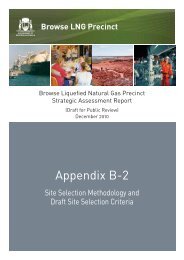Browse LNG Precinct - Public Information Booklet - Department of ...
Browse LNG Precinct - Public Information Booklet - Department of ...
Browse LNG Precinct - Public Information Booklet - Department of ...
You also want an ePaper? Increase the reach of your titles
YUMPU automatically turns print PDFs into web optimized ePapers that Google loves.
<strong>Public</strong> <strong>Information</strong> <strong>Booklet</strong><br />
� How far does the light go and does the heat destroy the environment?<br />
� How noisy will it be?<br />
� How long for start-up flare?<br />
Although flares are needed for the operation <strong>of</strong> the <strong>LNG</strong> facility, the normal operating<br />
case is to keep all flaring to an absolute minimum as the aim is to sell a much gas as<br />
possible as <strong>LNG</strong> and to reduce emissions wherever possible. Both the emergency flare<br />
and marine flare will only be used occasionally. The operational flare is much shorter and<br />
therefore wonít be that easy to see from a distance. Woodside is also looking at ways to<br />
reduce the number <strong>of</strong> times it is used, the amount <strong>of</strong> gas flared/burnt and how easy it is to<br />
see the operational flare.<br />
People will be able to see when the large emergency flare is used from a long distance<br />
away. However this does not happen very <strong>of</strong>ten and usually only lasts for a few minutes,<br />
with the flame size getting a lot smaller within 10 minutes.<br />
All <strong>of</strong> the flares are designed to deal with the largest amount <strong>of</strong> heat to be expected<br />
whether it is normal operations or the worst type <strong>of</strong> emergency possible. To protect<br />
people and the environment a series <strong>of</strong> criteria is placed on the maximum heat that can<br />
reach the ground. A relatively small exclusion zone at the base <strong>of</strong> the flare (a circle <strong>of</strong> a<br />
couple <strong>of</strong> hundred metres or around 219 yards) will be cleared. Outside <strong>of</strong> this the flare is<br />
highly unlikely to directly damage plants or animals. The environmental impacts from the<br />
light caused by the flare is expected to be fairly small due to the flaring events not<br />
happening very <strong>of</strong>ten. In addition, half <strong>of</strong> these events are likely to occur during the day<br />
when they will not increase the light impact.<br />
The noise <strong>of</strong> the flares will be considered as part <strong>of</strong> the Strategic Assessment. During an<br />
emergency event there will be a short period when the flare will be noisy. However this<br />
will only be for a few minutes as described previously. For the vast majority <strong>of</strong> the time,<br />
the noise <strong>of</strong> the flare is similar to the rest <strong>of</strong> the plant.<br />
Question - Can the flare be moved?<br />
The flare can be moved either north or south on the site. However, moving the<br />
emergency flare away from the coast (east/inland) has the following issues:<br />
� More land will be required. The marine flare must remain close to the <strong>LNG</strong> tanks, as<br />
the tanks operate at very low pressure and the gas can not flow large distances to<br />
reach the flare. If the marine, emergency and operational flares were moved apart, the<br />
sterile areas around each flare would no longer overlap. This will require more land to<br />
be used than the current layout. Note: the sterile area is the area in which there is too<br />
much heat from the flare to allow any people or equipment to remain, for the worst<br />
flaring situation.<br />
� The flare will be seen from further away. The slope <strong>of</strong> the land runs upwards away<br />
from the coast, if the flare is moved away from the coast the entire flare will be higher<br />
and easier to see from further away.<br />
� The piping and piperacks will be seen from further away. The slope <strong>of</strong> the land<br />
runs upwards away from the coast. The piping to all flares would normally have a<br />
5279225 54









